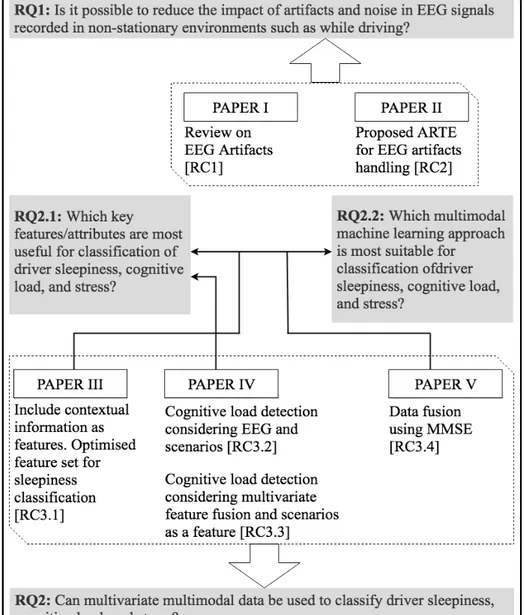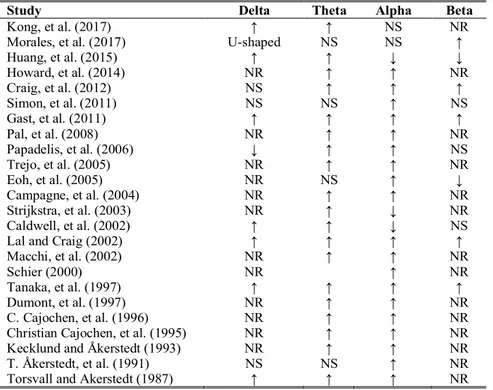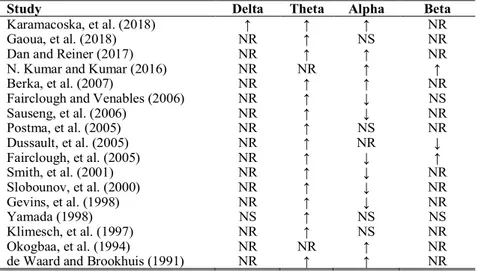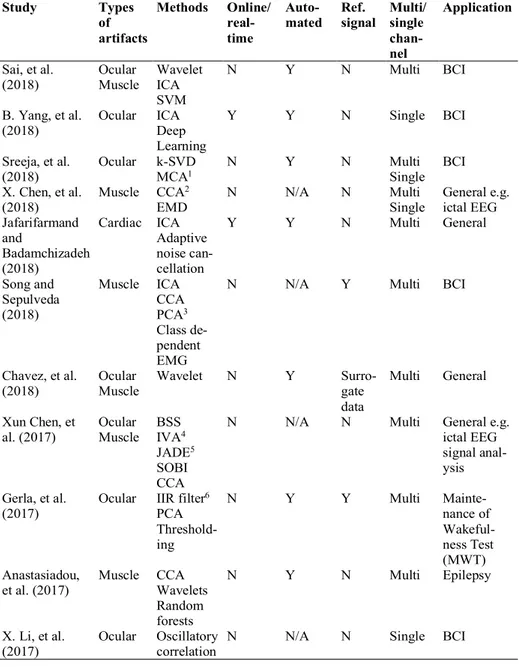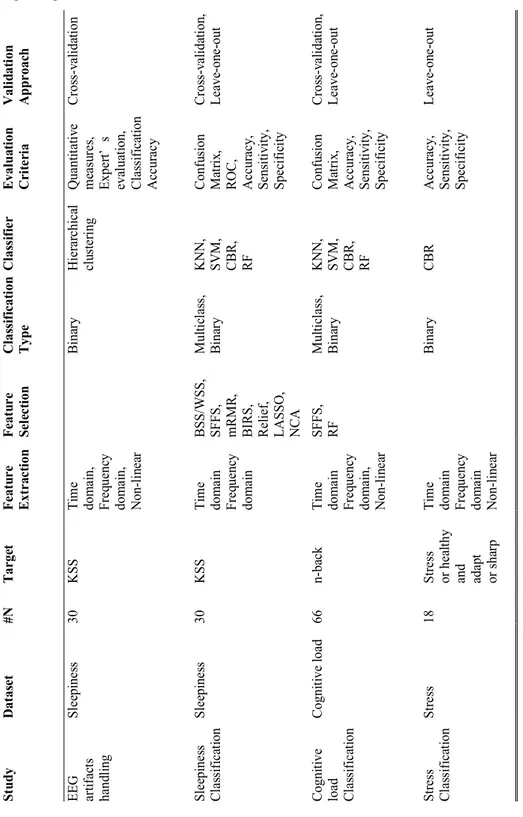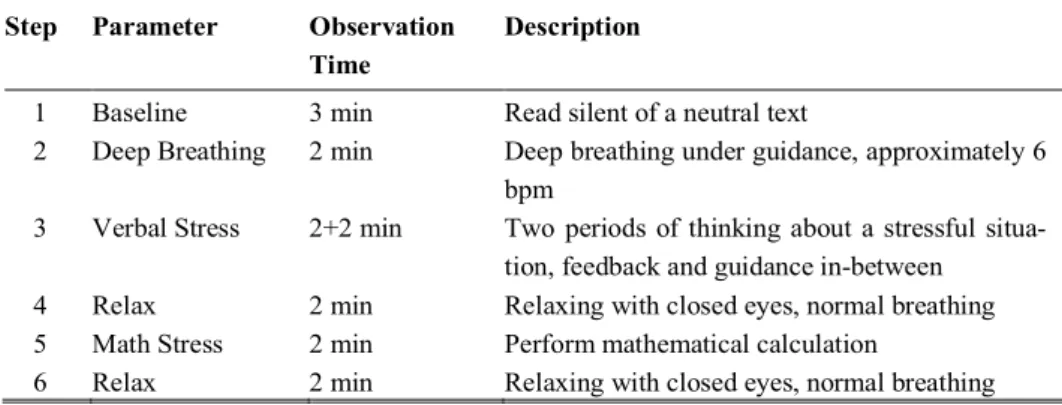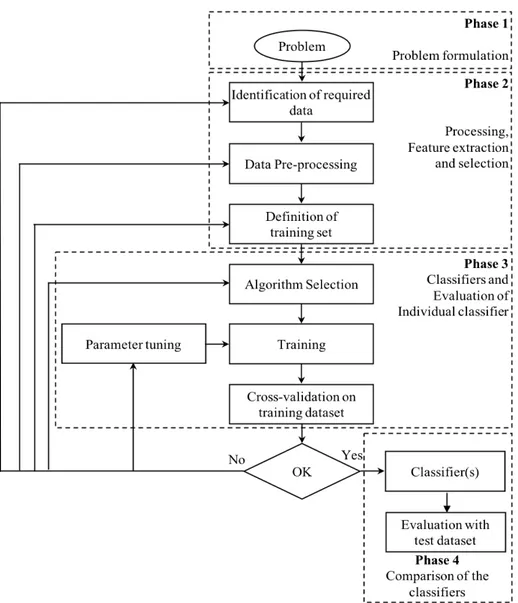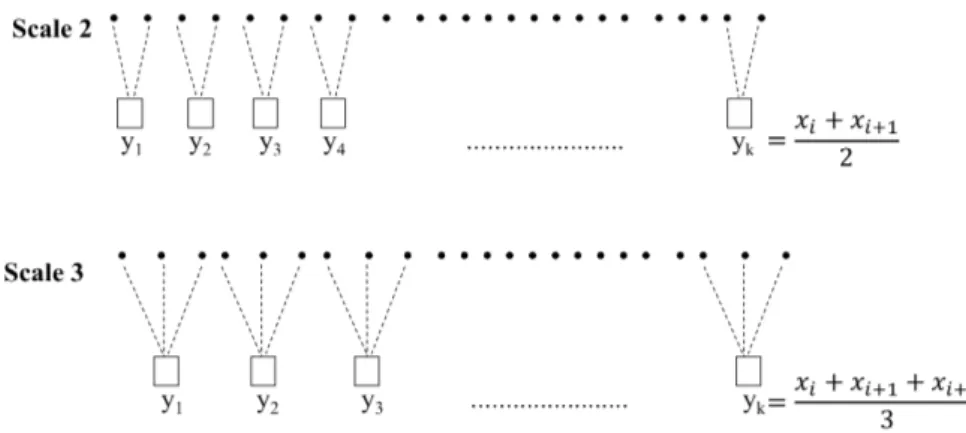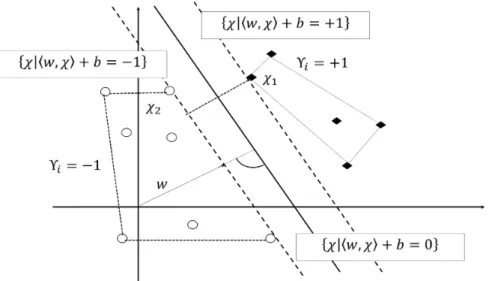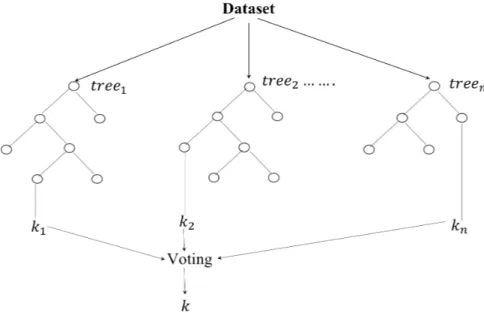u a M U LT IV A R IA TE D A TA A N A LY TIC S T O I D EN TIF Y D R IV ER ’S S LE EP IN ES S, C O G N IT IV E L O A D , A N D S TR ES S 20 19 ISBN 978-91-7485-419-0 Address: P.O. Box 883, SE-721 23 Västerås. Sweden
Address: P.O. Box 325, SE-631 05 Eskilstuna. Sweden
driver’s sleepiness, cognitive load,
and stress
Shaibal Barua cognitive load, and stress.
This thesis employs multivariate data analysis using machine learning to detect and classify different driver states based on physiological data. The reason for using rather intrusive sensor data, such as electro- encephalography (EEG), electrooculography (EOG), electrocardiography (ECG), skin conductance, finger temperature, and respiration is that these methods can be used to analyse how the brain and body respond to internal and external changes, including those that do not generate overt behaviour. Moreover, the use of physiological data is expected to grow in importance when investigating human behaviour in partially automated vehicles, where active driving is replaced by passive supervision.
Physiological data, especially the EEG is sensitive to motion artifacts and noise, and when record-ed in naturalistic environments such as driving, artifacts are unavoidable. An automatic EEG artifact handling method ARTE (Automated aRTifacts handling in EEG) was therefore developed. When used as a pre-processing step in the classification of driver sleepiness, ARTE increased classification performance by 5%. ARTE is data-driven and does not rely on additional reference signals or manually defined thresholds, making it well suited for use in dynamic settings where unforeseen and rare artifacts are commonly encountered. In addition, several machine-learning algorithms have been developed for sleepiness, cognitive load, and stress classification. Regarding sleepiness classification, the best achieved accuracy was achieved using a Support Vector Machine (SVM) classifier. For multiclass, the obtained accuracy was 79% and for binary class it was 93%. A subject-dependent classification exhibited a 10% improvement in performance compared to the subject-independent classification, suggesting that much can be gained by using personalized classifiers. Moreover, by embedding contextual information, classification performance improves by approximately 5%. In regard to cognitive load classification, a 72% accuracy rate was achieved using a random forest classifier. Combining features from several data sources may improve performance, and indeed, we observed classification performance improvement by 10%-20% compared to using features from a single data source. To classify drivers’ stress, using the Case-based reasoning (CBR) and data fusion approach, the system achieved an 83.33% classification accuracy rate.
This thesis work encourages the use of multivariate data for detecting and classifying driver states, including sleepiness, cognitive load, and stress. A univariate data source often presents challenges, since features from a single source or one just aspect of the feature are not entirely reliable; Therefore, multivariate information requires accurate driver state detection. Often, driver states are a subjective experience, in which other contextual data plays a vital role. Thus, the implication of incorporating contextual information in the classification scheme is presented in this thesis work. Although there are several commonalities, physiological signals are modulated differently in different driver states; Hence, multivariate data could help detect multiple driver states simultaneously – for example, cognitive load detection when a person is under the influence of different levels of stress.
Shaibal Barua received the M.Sc. degree in Computer Science, specialization in Software Engineering in 2012 and the Licentiate degree in Computer Sciencein 2015 from Mälardalen University, Västerås, Sweden. He has been a doctoral student at Mälardalen University since 2013. He is working in the research projects focus on driver state monitoring using physiological sensor signals and machine learning. His research interests include machine learning, multi-sensor data fusion, and applied artificial intelligence.
Mälardalen University Press Dissertations No. 284
MULTIVARIATE DATA ANALYTICS TO IDENTIFY
DRIVER’S SLEEPINESS, COGNITIVE LOAD, AND STRESS
Shaibal Barua 2019
School of Innovation, Design and Engineering
Mälardalen University Press Dissertations No. 284
MULTIVARIATE DATA ANALYTICS TO IDENTIFY
DRIVER’S SLEEPINESS, COGNITIVE LOAD, AND STRESS
Shaibal Barua 2019
Copyright © Shaibal Barua, 2019 ISBN 978-91-7485-419-0
ISSN 1651-4238
Printed by E-Print AB, Stockholm, Sweden
Copyright © Shaibal Barua, 2019 ISBN 978-91-7485-419-0
ISSN 1651-4238
Mälardalen University Press Dissertations No. 284
MULTIVARIATE DATA ANALYTICS TO IDENTIFY DRIVER’S SLEEPINESS, COGNITIVE LOAD, AND STRESS
Shaibal Barua
Akademisk avhandling
som för avläggande av teknologie doktorsexamen i datavetenskap vid Akademin för innovation, design och teknik kommer att offentligen försvaras
torsdagen den 21 februari 2019, 13.15 i Zeta, Mälardalens högskola, Västerås. Fakultetsopponent: Professor Nirmalie Wiratunga, Robert Gordon University
Akademin för innovation, design och teknik
Mälardalen University Press Dissertations No. 284
MULTIVARIATE DATA ANALYTICS TO IDENTIFY DRIVER’S SLEEPINESS, COGNITIVE LOAD, AND STRESS
Shaibal Barua
Akademisk avhandling
som för avläggande av teknologie doktorsexamen i datavetenskap vid Akademin för innovation, design och teknik kommer att offentligen försvaras
torsdagen den 21 februari 2019, 13.15 i Zeta, Mälardalens högskola, Västerås. Fakultetsopponent: Professor Nirmalie Wiratunga, Robert Gordon University
Abstract
Driving a vehicle in a dynamic traffic environment requires continuous adaptation of a complex manifold of physiological and cognitive activities. Impaired driving due to, for example, sleepiness, inattention, cognitive load or stress, affects one’s ability to adapt, predict and react to upcoming traffic events. In fact, human error has been found to be a contributing factor in more than 90% of traffic crashes. Unfortunately, there is no robust, objective ground truth for determining a driver’s state, and researchers often revert to using subjective self-rating scales when assessing level of sleepiness, cognitive load or stress. Thus, the development of better tools to understand, measure and monitor human behaviour across diverse scenarios and states is crucial. The main objective of this thesis is to develop objective measures of sleepiness, cognitive load and stress, which can later be used as research tools, either to benchmark unobtrusive sensor solutions or when investigating the influence of other factors on sleepiness, cognitive load, and stress.
This thesis employs multivariate data analysis using machine learning to detect and classify different driver states based on physiological data. The reason for using rather intrusive sensor data, such as electroencephalography (EEG), electrooculography (EOG), electrocardiography (ECG), skin conductance, finger temperature, and respiration is that these methods can be used to analyse how the brain and body respond to internal and external changes, including those that do not generate overt behaviour. Moreover, the use of physiological data is expected to grow in importance when investigating human behaviour in partially automated vehicles, where active driving is replaced by passive supervision.
Physiological data, especially the EEG is sensitive to motion artifacts and noise, and when recorded in naturalistic environments such as driving, artifacts are unavoidable. An automatic EEG artifact handling method ARTE (Automated aRTifacts handling in EEG) was therefore developed. When used as a pre-processing step in the classification of driver sleepiness, ARTE increased classification performance by 5%. ARTE is data-driven and does not rely on additional reference signals or manually defined thresholds, making it well suited for use in dynamic settings where unforeseen and rare artifacts are commonly encountered. In addition, several machine-learning algorithms have been developed for sleepiness, cognitive load, and stress classification. Regarding sleepiness classification, the best achieved accuracy was achieved using a Support Vector Machine (SVM) classifier. For multiclass, the obtained accuracy was 79% and for binary class it was 93%. A subject-dependent classification exhibited a 10% improvement in performance compared to the subject-independent classification, suggesting that much can be gained by using personalized classifiers. Moreover, by embedding contextual information, classification performance improves by approximately 5%. In regard to cognitive load classification, a 72% accuracy rate was achieved using a random forest classifier. Combining features from several data sources may improve performance, and indeed, we observed classification performance improvement by 10%-20% compared to using features from a single data source. To classify drivers’ stress, using the Case-based reasoning (CBR) and data fusion approach, the system achieved an 83.33% classification accuracy rate.
This thesis work encourages the use of multivariate data for detecting and classifying driver states, including sleepiness, cognitive load, and stress. A univariate data source often presents challenges, since features from a single source or one just aspect of the feature are not entirely reliable; Therefore, multivariate information requires accurate driver state detection. Often, driver states are a subjective experience, in which other contextual data plays a vital role. Thus, the implication of incorporating contextual information in the classification scheme is presented in this thesis work. Although there are several commonalities, physiological signals are modulated differently in different driver states; Hence, multivariate data could help detect multiple driver states simultaneously – for example, cognitive load detection when a person is under the influence of different levels of stress.
Abstract
Driving a vehicle in a dynamic traffic environment requires continuous adaptation of a complex manifold of physiological and cognitive activities. Impaired driving due to, for example, sleepiness, inattention, cognitive load or stress, affects one’s ability to adapt, predict and react to upcoming traffic events. In fact, human error has been found to be a contributing factor in more than 90% of traffic crashes. Unfortunately, there is no robust, objective ground truth for determining a driver’s state, and researchers often revert to using subjective self-rating scales when assessing level of sleepiness, cognitive load or stress. Thus, the development of better tools to understand, measure and monitor human behaviour across diverse scenarios and states is crucial. The main objective of this thesis is to develop objective measures of sleepiness, cognitive load and stress, which can later be used as research tools, either to benchmark unobtrusive sensor solutions or when investigating the influence of other factors on sleepiness, cognitive load, and stress.
This thesis employs multivariate data analysis using machine learning to detect and classify different driver states based on physiological data. The reason for using rather intrusive sensor data, such as electroencephalography (EEG), electrooculography (EOG), electrocardiography (ECG), skin conductance, finger temperature, and respiration is that these methods can be used to analyse how the brain and body respond to internal and external changes, including those that do not generate overt behaviour. Moreover, the use of physiological data is expected to grow in importance when investigating human behaviour in partially automated vehicles, where active driving is replaced by passive supervision.
Physiological data, especially the EEG is sensitive to motion artifacts and noise, and when recorded in naturalistic environments such as driving, artifacts are unavoidable. An automatic EEG artifact handling method ARTE (Automated aRTifacts handling in EEG) was therefore developed. When used as a pre-processing step in the classification of driver sleepiness, ARTE increased classification performance by 5%. ARTE is data-driven and does not rely on additional reference signals or manually defined thresholds, making it well suited for use in dynamic settings where unforeseen and rare artifacts are commonly encountered. In addition, several machine-learning algorithms have been developed for sleepiness, cognitive load, and stress classification. Regarding sleepiness classification, the best achieved accuracy was achieved using a Support Vector Machine (SVM) classifier. For multiclass, the obtained accuracy was 79% and for binary class it was 93%. A subject-dependent classification exhibited a 10% improvement in performance compared to the subject-independent classification, suggesting that much can be gained by using personalized classifiers. Moreover, by embedding contextual information, classification performance improves by approximately 5%. In regard to cognitive load classification, a 72% accuracy rate was achieved using a random forest classifier. Combining features from several data sources may improve performance, and indeed, we observed classification performance improvement by 10%-20% compared to using features from a single data source. To classify drivers’ stress, using the Case-based reasoning (CBR) and data fusion approach, the system achieved an 83.33% classification accuracy rate.
This thesis work encourages the use of multivariate data for detecting and classifying driver states, including sleepiness, cognitive load, and stress. A univariate data source often presents challenges, since features from a single source or one just aspect of the feature are not entirely reliable; Therefore, multivariate information requires accurate driver state detection. Often, driver states are a subjective experience, in which other contextual data plays a vital role. Thus, the implication of incorporating contextual information in the classification scheme is presented in this thesis work. Although there are several commonalities, physiological signals are modulated differently in different driver states; Hence, multivariate data could help detect multiple driver states simultaneously – for example, cognitive load detection when a person is under the influence of different levels of stress.
To the memory of my father and to my mother
To the memory of my father and to my mother
“If you torture the data long enough, Nature will confess” Ronal Coase
“If you torture the data long enough, Nature will confess” Ronal Coase
Acknowledgements
This long journey would not have been possible without the guidance, inspi-ration, and help of numerous people.
First and foremost, I am indebted to my supervisors, Associate Professor Shahina Begum, Prof. Peter Funk, and Associate Professor Dr. Mobyen Uddin Ahmed at Mälardalen University (MDH), and Dr. Christer Ahlström at the Swedish National Road and Transport Research Institute (VTI) for their pa-tience, invaluable knowledge and advice, valuable time, and guidance. I par-ticularly thank Associate Professors Begum and Ahmed for their uncondi-tional support of my Ph.D. study and related research. They have guided me throughout my Ph.D. education.
My special thanks to Dr. Ahlström, from whom I have learned much over the years.
I am grateful to everyone with whom I have had the pleasure to work on the Vehicle Driver Monitoring (VDM) project: Anna Anund and Carina Fors at the VTI, and Bo Svanberg, Per Lindén, Louise Walletun, Regina Johansson and Emma Nilsson at Volvo Car Corporation. Thank you all for your opinions and suggestions, offered on various occasions during our meetings.
I also wish to acknowledge everyone who worked on and helped with data collection in the VDM project. Many thanks to Miguel Rivera, Laura Salas, Stefan Danielsson, Isac Persson, and Erik Boström, who undertook their BSc and MSc thesis projects within the scope of the VDM project.
I am thankful to the professors at MDH from whom I have learned during my courses. I would also like to thank my colleagues Md Abu Naser Masud, Hamidur Rahman, Mir Riyanul Islam and Shahriar Hasan for their support. Many thanks to all the administrative staff at the School of Innovation Design and Engineering, Mälardalen University, for their unfailing help. Thanks to all my manager and colleagues at RISE SICS Västerås, particularly Markus Bohlin, Tomas Olsson, and Mats Tallfors.
Acknowledgements
This long journey would not have been possible without the guidance, inspi-ration, and help of numerous people.
First and foremost, I am indebted to my supervisors, Associate Professor Shahina Begum, Prof. Peter Funk, and Associate Professor Dr. Mobyen Uddin Ahmed at Mälardalen University (MDH), and Dr. Christer Ahlström at the Swedish National Road and Transport Research Institute (VTI) for their pa-tience, invaluable knowledge and advice, valuable time, and guidance. I par-ticularly thank Associate Professors Begum and Ahmed for their uncondi-tional support of my Ph.D. study and related research. They have guided me throughout my Ph.D. education.
My special thanks to Dr. Ahlström, from whom I have learned much over the years.
I am grateful to everyone with whom I have had the pleasure to work on the Vehicle Driver Monitoring (VDM) project: Anna Anund and Carina Fors at the VTI, and Bo Svanberg, Per Lindén, Louise Walletun, Regina Johansson and Emma Nilsson at Volvo Car Corporation. Thank you all for your opinions and suggestions, offered on various occasions during our meetings.
I also wish to acknowledge everyone who worked on and helped with data collection in the VDM project. Many thanks to Miguel Rivera, Laura Salas, Stefan Danielsson, Isac Persson, and Erik Boström, who undertook their BSc and MSc thesis projects within the scope of the VDM project.
I am thankful to the professors at MDH from whom I have learned during my courses. I would also like to thank my colleagues Md Abu Naser Masud, Hamidur Rahman, Mir Riyanul Islam and Shahriar Hasan for their support. Many thanks to all the administrative staff at the School of Innovation Design and Engineering, Mälardalen University, for their unfailing help. Thanks to all my manager and colleagues at RISE SICS Västerås, particularly Markus Bohlin, Tomas Olsson, and Mats Tallfors.
I would like to acknowledge the Swedish Governmental Agency for Inno-vation Systems (VINNOVA), Volvo Car Corporation, and VTI for financing the Vehicle Driver Monitoring (VDM) project.
Thank you, my friends: Husain, Jisa, Iftekhar, Shamsul Alam, Sobuz, and Kajsa, for your friendship and support over the years.
Finally, I express my deepest gratitude to my family members for their pa-tience, support, and encouragement.
Shaibal Barua January, 2019 Västerås, Sweden
I would like to acknowledge the Swedish Governmental Agency for Inno-vation Systems (VINNOVA), Volvo Car Corporation, and VTI for financing the Vehicle Driver Monitoring (VDM) project.
Thank you, my friends: Husain, Jisa, Iftekhar, Shamsul Alam, Sobuz, and Kajsa, for your friendship and support over the years.
Finally, I express my deepest gratitude to my family members for their pa-tience, support, and encouragement.
Shaibal Barua January, 2019 Västerås, Sweden
Abstract
Driving a vehicle in a dynamic traffic environment requires continuous adap-tation of a complex manifold of physiological and cognitive activities. Im-paired driving due to, for example, sleepiness, inattention, cognitive load or stress, affects one’s ability to adapt, predict and react to upcoming traffic events. In fact, human error has been found to be a contributing factor in more than 90% of traffic crashes. Unfortunately, there is no robust, objective ground truth for determining a driver’s state, and researchers often revert to using subjective self-rating scales when assessing level of sleepiness, cognitive load or stress. Thus, the development of better tools to understand, measure and monitor human behaviour across diverse scenarios and states is crucial. The main objective of this thesis is to develop objective measures of sleepiness, cognitive load and stress, which can later be used as research tools, either to benchmark unobtrusive sensor solutions or when investigating the influence of other factors on sleepiness, cognitive load, and stress.
This thesis employs multivariate data analysis using machine learning to detect and classify different driver states based on physiological data. The rea-son for using rather intrusive sensor data, such as electroencephalography (EEG), electrooculography (EOG), electrocardiography (ECG), skin conduct-ance, finger temperature, and respiration is that these methods can be used to analyse how the brain and body respond to internal and external changes, in-cluding those that do not generate overt behaviour. Moreover, the use of phys-iological data is expected to grow in importance when investigating human behaviour in partially automated vehicles, where active driving is replaced by passive supervision.
Physiological data, especially the EEG is sensitive to motion artifacts and noise, and when recorded in naturalistic environments such as driving, arti-facts are unavoidable. An automatic EEG artifact handling method ARTE (Automated aRTifacts handling in EEG) was therefore developed. When used as a pre-processing step in the classification of driver sleepiness, ARTE in-creased classification performance by 5%. ARTE is data-driven and does not rely on additional reference signals or manually defined thresholds, making it well suited for use in dynamic settings where unforeseen and rare artifacts are commonly encountered. In addition, several machine-learning algorithms have been developed for sleepiness, cognitive load, and stress classification. Regarding sleepiness classification, the best achieved accuracy was achieved
Abstract
Driving a vehicle in a dynamic traffic environment requires continuous adap-tation of a complex manifold of physiological and cognitive activities. Im-paired driving due to, for example, sleepiness, inattention, cognitive load or stress, affects one’s ability to adapt, predict and react to upcoming traffic events. In fact, human error has been found to be a contributing factor in more than 90% of traffic crashes. Unfortunately, there is no robust, objective ground truth for determining a driver’s state, and researchers often revert to using subjective self-rating scales when assessing level of sleepiness, cognitive load or stress. Thus, the development of better tools to understand, measure and monitor human behaviour across diverse scenarios and states is crucial. The main objective of this thesis is to develop objective measures of sleepiness, cognitive load and stress, which can later be used as research tools, either to benchmark unobtrusive sensor solutions or when investigating the influence of other factors on sleepiness, cognitive load, and stress.
This thesis employs multivariate data analysis using machine learning to detect and classify different driver states based on physiological data. The rea-son for using rather intrusive sensor data, such as electroencephalography (EEG), electrooculography (EOG), electrocardiography (ECG), skin conduct-ance, finger temperature, and respiration is that these methods can be used to analyse how the brain and body respond to internal and external changes, in-cluding those that do not generate overt behaviour. Moreover, the use of phys-iological data is expected to grow in importance when investigating human behaviour in partially automated vehicles, where active driving is replaced by passive supervision.
Physiological data, especially the EEG is sensitive to motion artifacts and noise, and when recorded in naturalistic environments such as driving, arti-facts are unavoidable. An automatic EEG artifact handling method ARTE (Automated aRTifacts handling in EEG) was therefore developed. When used as a pre-processing step in the classification of driver sleepiness, ARTE in-creased classification performance by 5%. ARTE is data-driven and does not rely on additional reference signals or manually defined thresholds, making it well suited for use in dynamic settings where unforeseen and rare artifacts are commonly encountered. In addition, several machine-learning algorithms have been developed for sleepiness, cognitive load, and stress classification. Regarding sleepiness classification, the best achieved accuracy was achieved
using a Support Vector Machine (SVM) classifier. For multiclass, the obtained accuracy was 79% and for binary class it was 93%. A subject-dependent clas-sification exhibited a 10% improvement in performance compared to the sub-ject-independent classification, suggesting that much can be gained by using personalized classifiers. Moreover, by embedding contextual information, classification performance improves by approximately 5%. In regard to cog-nitive load classification, a 72% accuracy rate was achieved using a random forest classifier. Combining features from several data sources may improve performance, and indeed, we observed classification performance improve-ment by 10%-20% compared to using features from a single data source. To classify drivers’ stress, using the Case-based reasoning (CBR) and data fusion approach, the system achieved an 83.33% classification accuracy rate.
This thesis work encourages the use of multivariate data for detecting and classifying driver states, including sleepiness, cognitive load, and stress. A univariate data source often presents challenges, since features from a single source or one just aspect of the feature are not entirely reliable; Therefore, multivariate information requires accurate driver state detection. Often, driver states are a subjective experience, in which other contextual data plays a vital role. Thus, the implication of incorporating contextual information in the clas-sification scheme is presented in this thesis work. Although there are several commonalities, physiological signals are modulated differently in different driver states; Hence, multivariate data could help detect multiple driver states simultaneously – for example, cognitive load detection when a person is under the influence of different levels of stress.
using a Support Vector Machine (SVM) classifier. For multiclass, the obtained accuracy was 79% and for binary class it was 93%. A subject-dependent clas-sification exhibited a 10% improvement in performance compared to the sub-ject-independent classification, suggesting that much can be gained by using personalized classifiers. Moreover, by embedding contextual information, classification performance improves by approximately 5%. In regard to cog-nitive load classification, a 72% accuracy rate was achieved using a random forest classifier. Combining features from several data sources may improve performance, and indeed, we observed classification performance improve-ment by 10%-20% compared to using features from a single data source. To classify drivers’ stress, using the Case-based reasoning (CBR) and data fusion approach, the system achieved an 83.33% classification accuracy rate.
This thesis work encourages the use of multivariate data for detecting and classifying driver states, including sleepiness, cognitive load, and stress. A univariate data source often presents challenges, since features from a single source or one just aspect of the feature are not entirely reliable; Therefore, multivariate information requires accurate driver state detection. Often, driver states are a subjective experience, in which other contextual data plays a vital role. Thus, the implication of incorporating contextual information in the clas-sification scheme is presented in this thesis work. Although there are several commonalities, physiological signals are modulated differently in different driver states; Hence, multivariate data could help detect multiple driver states simultaneously – for example, cognitive load detection when a person is under the influence of different levels of stress.
Sammanfattning
Att framföra ett fordon i en dynamisk trafikmiljö kräver kontinuerlig anpass-ning av en komplex mångfald av fysiologiska och kognitiva aktiviteter. För-sämrad körförmåga (till exempel på grund av sömnighet, ouppmärksamhet, kognitiv belastning eller stress) påverkar förmågan att kunna anpassa sig till, förutse och reagera på det som händer i trafikmiljön. I själva verket ligger mänskliga misstag bakom mer än 90% av trafikolyckorna. Tyvärr finns det ingen objektiv tillförlitlig metod för att mäta förartillstånd, och inom forsk-ningen använder man därför ofta subjektiva skattningsskalor för att estimera nivån av sömnighet, kognitiv belastning och stress. Att utveckla bättre verktyg för att mäta och förstå förarbeteende i olika scenarion och tillstånd är därför av yttersta vikt. Det huvudsakliga målet med den här avhandlingen är därför att utveckla objektiva mått för sömnighet, kognitiv belastning och stress. Dessa kan sedan användas som forskningsverktyg, antingen för att utvärdera mindre invasiva sensorlösningar eller för att undersöka inflytandet av andra faktorer på sömnighet, kognitiv belastning och stress.
I den här avhandlingen används på flervariabel dataanalys och maskinin-lärning för att detektera och klassificera olika förartillstånd baserat på fysio-logiska data. Anledningen till att använda elektroder vid insamlandet av dessa fysiologiska data (elektroencefalografi (EEG), elektrookulografi (EOG), elektrokardiografi (EKG), hudens ledningsförmåga, fingertemperatur och andning) är att dessa signaler speglar hur hjärnan och kroppen svarar på in-terna och exin-terna förändringar.
Fysiologiska data är känsliga för rörelseartefakter och mätbrus, och data insamlade under realistiska förhållanden (som bilkörning) kommer oundvik-ligen att innehålla många artefakter. En automatisk metod kallad ARTE (Automatisk aRTefakthantering av EEG) har därför utvecklats för att minska inverkan av artefakter i EEG data. När ARTE används för att förbehandla EEG data innan den används för att klassificera förarsömnighet så förbättras klassificeringsprestanda med 5%. ARTE är en datadriven metod som inte är beroende av ytterligare referenssignaler eller manuellt injusterade tröskelvär-den. Det gör ARTE väl lämpad för användning under dynamiska förhållanden där oväntade och ovanliga artefakter är vanliga.
I avhandlingen presenteras flera maskininlärningsalgoritmer för klassifice-ring av sömnighet, kognitiv belastning och stress. För klassificeklassifice-ring av söm-nighet uppnåddes en noggrannhet på 79% för ”multiclass” och 93% för binär klassificering vid användning av en stödvektormaskin (SVM).
Sammanfattning
Att framföra ett fordon i en dynamisk trafikmiljö kräver kontinuerlig anpass-ning av en komplex mångfald av fysiologiska och kognitiva aktiviteter. För-sämrad körförmåga (till exempel på grund av sömnighet, ouppmärksamhet, kognitiv belastning eller stress) påverkar förmågan att kunna anpassa sig till, förutse och reagera på det som händer i trafikmiljön. I själva verket ligger mänskliga misstag bakom mer än 90% av trafikolyckorna. Tyvärr finns det ingen objektiv tillförlitlig metod för att mäta förartillstånd, och inom forsk-ningen använder man därför ofta subjektiva skattningsskalor för att estimera nivån av sömnighet, kognitiv belastning och stress. Att utveckla bättre verktyg för att mäta och förstå förarbeteende i olika scenarion och tillstånd är därför av yttersta vikt. Det huvudsakliga målet med den här avhandlingen är därför att utveckla objektiva mått för sömnighet, kognitiv belastning och stress. Dessa kan sedan användas som forskningsverktyg, antingen för att utvärdera mindre invasiva sensorlösningar eller för att undersöka inflytandet av andra faktorer på sömnighet, kognitiv belastning och stress.
I den här avhandlingen används på flervariabel dataanalys och maskinin-lärning för att detektera och klassificera olika förartillstånd baserat på fysio-logiska data. Anledningen till att använda elektroder vid insamlandet av dessa fysiologiska data (elektroencefalografi (EEG), elektrookulografi (EOG), elektrokardiografi (EKG), hudens ledningsförmåga, fingertemperatur och andning) är att dessa signaler speglar hur hjärnan och kroppen svarar på in-terna och exin-terna förändringar.
Fysiologiska data är känsliga för rörelseartefakter och mätbrus, och data insamlade under realistiska förhållanden (som bilkörning) kommer oundvik-ligen att innehålla många artefakter. En automatisk metod kallad ARTE (Automatisk aRTefakthantering av EEG) har därför utvecklats för att minska inverkan av artefakter i EEG data. När ARTE används för att förbehandla EEG data innan den används för att klassificera förarsömnighet så förbättras klassificeringsprestanda med 5%. ARTE är en datadriven metod som inte är beroende av ytterligare referenssignaler eller manuellt injusterade tröskelvär-den. Det gör ARTE väl lämpad för användning under dynamiska förhållanden där oväntade och ovanliga artefakter är vanliga.
I avhandlingen presenteras flera maskininlärningsalgoritmer för klassifice-ring av sömnighet, kognitiv belastning och stress. För klassificeklassifice-ring av söm-nighet uppnåddes en noggrannhet på 79% för ”multiclass” och 93% för binär klassificering vid användning av en stödvektormaskin (SVM).
Individanpassad klassificering förbättrade resultatet med 10%. Det tyder på att mycket kan vinnas genom att individanpassa algoritmerna. Dessutom för-bättrades resultaten med ytterligare cirka 5% genom att lägga till information om omgivningen.
Vid klassificeringen av kognitiv belastning uppnåddes en noggrannhet på 72% med en så kallad ”random forest”-klassificerare. Genom att använda in-formation från flera olika datakällor förbättrades resultaten med 10–20%jäm-fört med att bara använda enskilda datakällor. För klassificering av stress, med hjälp av en ansats med fallbaserat resonerande (CBR) och datafusion så upp-nådde systemet en noggrannhet på 83,33%.
Arbetet som är gjort i den här avhandlingen rekommenderar att flervariabla data ska användas för detektering och klassificering av förartillstånd, speciellt om flera olika tillstånd ska klassificeras samtidigt. Ofta är förartillstånd sub-jektiva upplevelser där mycket annan kontextuell data kan spela en avgörande roll. Det är därför viktigt att klassificeraren får tillgång till den typen av in-formation.
Individanpassad klassificering förbättrade resultatet med 10%. Det tyder på att mycket kan vinnas genom att individanpassa algoritmerna. Dessutom för-bättrades resultaten med ytterligare cirka 5% genom att lägga till information om omgivningen.
Vid klassificeringen av kognitiv belastning uppnåddes en noggrannhet på 72% med en så kallad ”random forest”-klassificerare. Genom att använda in-formation från flera olika datakällor förbättrades resultaten med 10–20%jäm-fört med att bara använda enskilda datakällor. För klassificering av stress, med hjälp av en ansats med fallbaserat resonerande (CBR) och datafusion så upp-nådde systemet en noggrannhet på 83,33%.
Arbetet som är gjort i den här avhandlingen rekommenderar att flervariabla data ska användas för detektering och klassificering av förartillstånd, speciellt om flera olika tillstånd ska klassificeras samtidigt. Ofta är förartillstånd sub-jektiva upplevelser där mycket annan kontextuell data kan spela en avgörande roll. Det är därför viktigt att klassificeraren får tillgång till den typen av in-formation.
List of Papers
This thesis is based on the following papers, which are referred to in the text by their Roman numerals.
I Barua, S., Begum, S. (2014) A Review on Machine Learning Al-gorithms in Handling EEG Artifacts. In the proceeding of the
Swedish AI Society (SAIS) Workshop, Stockholm, Sweden
II Barua, S., Ahmed, M. U., Ahlstrom, C., Begum S., Funk, P. (2018) Automated EEG Artifact Handling with Application in Driver Monitoring. IEEE Journal of Biomedical and Health
In-formatics, 22(5):1350–1361, doi: 10.1109/JBHI.2017.2773999
III Barua, S., Ahmed, M. U., Ahlstrom, C., Begum, S. (2018) Auto-matic Driver Sleepiness Detection using EEG, EOG, and Con-textual Information. Expert Systems with Applications, 115 (Jan-uary 2019):121–135, https://doi.org/10.1016/j.eswa.2018.07.054 IV Barua, S., Ahmed, M. U., Begum, S. (2017) Classifying Drivers’ Cognitive Load using EEG Signals. Studies in Health
Technol-ogy and Informatics, 237(pHealth2017):99-106, DOI 10.3233/978-1-61499-761-0-99
V Begum, S., Barua, S., Filla, R., Ahmed, M. U. (2014) Classifica-tion of physiological signals for wheel loader operators using Multi-scale Entropy analysis and case-based reasoning. Expert
Systems with Applications, 41(2):295–305, ISSN 0957-4174
List of Papers
This thesis is based on the following papers, which are referred to in the text by their Roman numerals.
I Barua, S., Begum, S. (2014) A Review on Machine Learning Al-gorithms in Handling EEG Artifacts. In the proceeding of the
Swedish AI Society (SAIS) Workshop, Stockholm, Sweden
II Barua, S., Ahmed, M. U., Ahlstrom, C., Begum S., Funk, P. (2018) Automated EEG Artifact Handling with Application in Driver Monitoring. IEEE Journal of Biomedical and Health
In-formatics, 22(5):1350–1361, doi: 10.1109/JBHI.2017.2773999
III Barua, S., Ahmed, M. U., Ahlstrom, C., Begum, S. (2018) Auto-matic Driver Sleepiness Detection using EEG, EOG, and Con-textual Information. Expert Systems with Applications, 115 (Jan-uary 2019):121–135, https://doi.org/10.1016/j.eswa.2018.07.054 IV Barua, S., Ahmed, M. U., Begum, S. (2017) Classifying Drivers’ Cognitive Load using EEG Signals. Studies in Health
Technol-ogy and Informatics, 237(pHealth2017):99-106, DOI 10.3233/978-1-61499-761-0-99
V Begum, S., Barua, S., Filla, R., Ahmed, M. U. (2014) Classifica-tion of physiological signals for wheel loader operators using Multi-scale Entropy analysis and case-based reasoning. Expert
Publications not included in the thesis
Journals
• Begum, S., Barua, S., Ahmed, M. U. (2017) In-Vehicle Stress Moni-toring Based on EEG Signal. Journal of Engineering Research and
Applications (IJERA), Vol-7, No-7, pages-55-71
• Begum, S., Barua, S., Ahmed, M. U. (2014) Physiological Sensor Sig-nals Classification for Healthcare Using Sensor Data Fusion and Case-Based Reasoning. Sensors (Special Issue Sensors Data Fusion
for Healthcare), No-7, 1770-11785
Conference/Workshop
• Barua, S., Ahmed, M. U., Begum, S. (2017) Distributed Multivariate Physiological Signal Analytics for Drivers’ Mental State Monitoring.
Proceeding of the 4th EAI International Conference on IoT Technol-ogies for HealthCare (HealthyIoT'17), Angers, France
• Rahman, H., Barua, S., Ahmed, M. U., Begum, S., Hök, B. (2016) A Case-Based Classification for Drivers’ Alcohol Detection Using Physiological Signals. In the Proceeding of the 3rd EAI International
Conference on IoT Technologies for HealthCare (HealthyIoT'16),
Crete, Greece
• Barua, S., Begum, S., Ahmed, M. U. (2016) Driver’s State Monitor-ing: A Case Study on Big Data Analytics. In the Proceeding of the
3rd EAI International Conference on IoT Technologies for HealthCare (HealthyIoT'16), Västerås, Sweden
• Barua, S., Begum, S., Ahmed, M. U., Ahlström, C. (2016) Automated EEG Artifacts Handling for Driver Sleepiness Monitoring. In the 2nd
International Symposium on Somnolence, Vigilance, and Safety (Som-noSafe2016), Brussels, Belgium
• Barua, S., Begum, S., Ahmed, M. U. (2015) Clustering based Ap-proach for Automated EEG Artifacts Handling. Proceeding of the
13th Scandinavian Conference on Artificial Intelligence (SCAI 2015),
Halmstad, Sweden
Publications not included in the thesis
Journals
• Begum, S., Barua, S., Ahmed, M. U. (2017) In-Vehicle Stress Moni-toring Based on EEG Signal. Journal of Engineering Research and
Applications (IJERA), Vol-7, No-7, pages-55-71
• Begum, S., Barua, S., Ahmed, M. U. (2014) Physiological Sensor Sig-nals Classification for Healthcare Using Sensor Data Fusion and Case-Based Reasoning. Sensors (Special Issue Sensors Data Fusion
for Healthcare), No-7, 1770-11785
Conference/Workshop
• Barua, S., Ahmed, M. U., Begum, S. (2017) Distributed Multivariate Physiological Signal Analytics for Drivers’ Mental State Monitoring.
Proceeding of the 4th EAI International Conference on IoT Technol-ogies for HealthCare (HealthyIoT'17), Angers, France
• Rahman, H., Barua, S., Ahmed, M. U., Begum, S., Hök, B. (2016) A Case-Based Classification for Drivers’ Alcohol Detection Using Physiological Signals. In the Proceeding of the 3rd EAI International
Conference on IoT Technologies for HealthCare (HealthyIoT'16),
Crete, Greece
• Barua, S., Begum, S., Ahmed, M. U. (2016) Driver’s State Monitor-ing: A Case Study on Big Data Analytics. In the Proceeding of the
3rd EAI International Conference on IoT Technologies for HealthCare (HealthyIoT'16), Västerås, Sweden
• Barua, S., Begum, S., Ahmed, M. U., Ahlström, C. (2016) Automated EEG Artifacts Handling for Driver Sleepiness Monitoring. In the 2nd
International Symposium on Somnolence, Vigilance, and Safety (Som-noSafe2016), Brussels, Belgium
• Barua, S., Begum, S., Ahmed, M. U. (2015) Clustering based Ap-proach for Automated EEG Artifacts Handling. Proceeding of the
13th Scandinavian Conference on Artificial Intelligence (SCAI 2015),
• Barua, S., Begum, S., Ahmed, M. U. (2016) Intelligent Automated EEG Artifacts Handling Using Wavelet Transform, Independent Component Analysis and Hierarchal clustering. In: Perego P.,
Andre-oni G., Rizzo G. (eds) Wireless Mobile Communication and Healthcare. MobiHealth 2016. Lecture Notes of the Institute for Com-puter Sciences, Social Informatics and Telecommunications Engi-neering, vol 192. Springer, Cham
• Rahman, H., Barua, S., Begum, S. (2015) Intelligent Driver Monitor-ing Based on Physiological Sensor Signals: Application UsMonitor-ing Cam-era. Proceeding of the IEEE 18th International Conference on
Intel-ligent Transportation Systems (ITSC2015), Las Palmas de Gran
Ca-naria, Spain
• Barua, S., Begum, S., Ahmed, M. U. (2015) Supervised Machine Learning Algorithms to Diagnose Stress for Vehicle Drivers Based on Physiological Sensor Signals. Studies in Health Technology and
In-formatics, 211(pHealth 2015):241-248, DOI
10.3233/978-1-61499-516-6-241
• Barua, S., Begum, S., Ahmed, M. U., Funk, P. (2014) A Fusion Based System for Physiological Sensor Signal Classification. In proceeding
of the 16th Nordic-Baltic Conference on Biomedical Engineering & Medical Physics and Medicinteknikdagarna, Gothenburg, Sweden,
2014
• Barua, S., Begum, S., Ahmed, M. U., Funk, P. (2014) Classification of Ocular Artifacts in EEG Signals Using Hierarchical Clustering and Case-based Reasoning. Proceeding of the workshop on Synergies
be-tween CBR and Data Mining at 22nd International Conference on Case-Based Reasoning (CBRDM'14), Cork, Ireland
• Barua, S., Begum, S. (2013) EEG Sensor Based Classification for As-sessing Psychological Stress. Studies in Health Technology and
Infor-matics, 189(pHealth 2013):83-88, DOI
10.3233/978-1-61499-268-4-83
• Barua, S., Begum, S., Ahmed, M. U. (2012) Multi-Scale Entropy Analysis and Case-Based Reasoning to Classify Physiological Sensor Signals. Proceeding of the Workshop on CBR in the Health Sciences
at 20th International Conference on Case-Based Reasoning, Lyon,
France
• Barua, S., Begum, S., Ahmed, M. U. (2016) Intelligent Automated EEG Artifacts Handling Using Wavelet Transform, Independent Component Analysis and Hierarchal clustering. In: Perego P.,
Andre-oni G., Rizzo G. (eds) Wireless Mobile Communication and Healthcare. MobiHealth 2016. Lecture Notes of the Institute for Com-puter Sciences, Social Informatics and Telecommunications Engi-neering, vol 192. Springer, Cham
• Rahman, H., Barua, S., Begum, S. (2015) Intelligent Driver Monitor-ing Based on Physiological Sensor Signals: Application UsMonitor-ing Cam-era. Proceeding of the IEEE 18th International Conference on
Intel-ligent Transportation Systems (ITSC2015), Las Palmas de Gran
Ca-naria, Spain
• Barua, S., Begum, S., Ahmed, M. U. (2015) Supervised Machine Learning Algorithms to Diagnose Stress for Vehicle Drivers Based on Physiological Sensor Signals. Studies in Health Technology and
In-formatics, 211(pHealth 2015):241-248, DOI
10.3233/978-1-61499-516-6-241
• Barua, S., Begum, S., Ahmed, M. U., Funk, P. (2014) A Fusion Based System for Physiological Sensor Signal Classification. In proceeding
of the 16th Nordic-Baltic Conference on Biomedical Engineering & Medical Physics and Medicinteknikdagarna, Gothenburg, Sweden,
2014
• Barua, S., Begum, S., Ahmed, M. U., Funk, P. (2014) Classification of Ocular Artifacts in EEG Signals Using Hierarchical Clustering and Case-based Reasoning. Proceeding of the workshop on Synergies
be-tween CBR and Data Mining at 22nd International Conference on Case-Based Reasoning (CBRDM'14), Cork, Ireland
• Barua, S., Begum, S. (2013) EEG Sensor Based Classification for As-sessing Psychological Stress. Studies in Health Technology and
Infor-matics, 189(pHealth 2013):83-88, DOI
10.3233/978-1-61499-268-4-83
• Barua, S., Begum, S., Ahmed, M. U. (2012) Multi-Scale Entropy Analysis and Case-Based Reasoning to Classify Physiological Sensor Signals. Proceeding of the Workshop on CBR in the Health Sciences
at 20th International Conference on Case-Based Reasoning, Lyon,
Publication in another domain (Conference/Workshop)
• Barua, S., Begum, S., Ahmed M. U. (2018) Towards Distributed k-NN similarity for Scalable Case Retrieval. The Third Workshop on
Synergies between CBR and Machine Learning (CBRML 2018) at 26th International Conference on Case-Based Reasoning, Stockholm,
Sweden
• Ahmed, M. U., Andersson, P., Andersson, T., Aparicio, E. T., Baaz, H., Barua, S., Bergström, A., Bengtsson, D., Skvaril, J., Zambrano, J. (2018) Real-time Biomass Characterization in Energy Conversion Processes using Near Infrared Spectroscopy - A Machine Learning Approach. 10th International Conference on Applied Energy
(ICAE2018), Hong Kong
• Barua, S., Begum, S., Ahmed, M. U. (2017) Scalable Framework for Distributed Case-based Reasoning for Big data analytics. Proceeding
of the 4th EAI International Conference on IoT Technologies for HealthCare (HealthyIoT'17), Angers, France
• Begum, S., Kerstis, B., Barua, S., Westerlund, H., Hjortsberg, C. (2017) Food4You: A Personalized System for Adaptive Mealtime Sit-uations for Elderly. Medicinteknikdagarna (MTD 2017), Västerås, Sweden
Report
• Nilsson, E., Ahlström, C., Barua, S., Fors, C., Lindén, P., Svanberg, B., Begum, S., Ahmed, M. U., Anund, A. (2017) Vehicle Driver Mon-itoring: sleepiness and cognitive load. VTI rapport 937A, Swedish
Na-tional Road and Transport Research Institute, Linköping, Sweden
Publication in another domain (Conference/Workshop)
• Barua, S., Begum, S., Ahmed M. U. (2018) Towards Distributed k-NN similarity for Scalable Case Retrieval. The Third Workshop on
Synergies between CBR and Machine Learning (CBRML 2018) at 26th International Conference on Case-Based Reasoning, Stockholm,
Sweden
• Ahmed, M. U., Andersson, P., Andersson, T., Aparicio, E. T., Baaz, H., Barua, S., Bergström, A., Bengtsson, D., Skvaril, J., Zambrano, J. (2018) Real-time Biomass Characterization in Energy Conversion Processes using Near Infrared Spectroscopy - A Machine Learning Approach. 10th International Conference on Applied Energy
(ICAE2018), Hong Kong
• Barua, S., Begum, S., Ahmed, M. U. (2017) Scalable Framework for Distributed Case-based Reasoning for Big data analytics. Proceeding
of the 4th EAI International Conference on IoT Technologies for HealthCare (HealthyIoT'17), Angers, France
• Begum, S., Kerstis, B., Barua, S., Westerlund, H., Hjortsberg, C. (2017) Food4You: A Personalized System for Adaptive Mealtime Sit-uations for Elderly. Medicinteknikdagarna (MTD 2017), Västerås, Sweden
Report
• Nilsson, E., Ahlström, C., Barua, S., Fors, C., Lindén, P., Svanberg, B., Begum, S., Ahmed, M. U., Anund, A. (2017) Vehicle Driver Mon-itoring: sleepiness and cognitive load. VTI rapport 937A, Swedish
List of Figures
FIGURE 1.1: ASSOCIATION BETWEEN RESEARCH QUESTIONS AND CONTRIBUTIONS. ... 8
FIGURE 3.1: VTI SIMULATOR III AND EEG ELECTRODES SETUP ON A PARTICIPANT... 25
FIGURE 3.2: RESEARCH PROCESS FOR SUPERVISED MACHINE LEARNING SETUP FOLLOWED IN THE THESIS STUDY, ADAPTED FROM (KOTSIANTIS, 2007), MODIFIED WITH PHASES TO FIT THE RESEARCH PROCESS. ... 28
FIGURE 3.3: ILLUSTRATION OF COARSE-GRAINED PROCESS IN MMSE FOR SCALE FACTOR 2 AND SCALE FACTOR 3 ... 30
FIGURE 3.4: FEATURE SELECTION PROCESS USING WRAPPER METHODS ... 32
FIGURE 3.5: FEATURE SELECTION PROCESS USING FILTER METHODS ... 33
FIGURE 3.6: AN EXAMPLE OF SVM SEPARATION OF 2-DIMENSIONAL BINARY CLASS PROBLEM.
THE SOLID LINE REPRESENTS THE OPTIMAL HYPERPLANE, DOTTED LINE DENOTES MAXIMAL MARGIN; CIRCLES AND DIAMONDS ON THE MARGIN ARE THE SUPPORT VECTORS (HEARST, ET AL., 1998). HERE, 𝑤 IS THE WEIGHT VECTOR AND 𝑏 IS THE THRESHOLD SUCH THAT Υ𝑖𝑤, 𝜒𝑖 + 𝑏 > 0𝑖 = 1, … … , 𝑁. ... 34
FIGURE 3.7: GENERIC STRUCTURE OF RANDOM FOREST CLASSIFICATION ... 35
FIGURE 3.8: CBR CYCLE ADAPTED FROM AAMODT AND PLAZA (1994) ... 36
FIGURE 3.9: (A) POINTS FALLING IN THREE CLUSTERS, (B) THE DENDROGRAM
REPRESENTATION (JAIN, ET AL., 1999) ... 37
FIGURE 4.1: EXAMPLE SHOWING A 10-SECOND SEGMENT FROM THE FIRST 15 RAW EEG DATA CHANNELS (BLACK) ALONG WITH THE CLEANED EEG DATA AFTER APPLYING
ARTE (GREEN). ... 40
FIGURE 4.2: THE REMAINING 15 CHANNELS FROM FIGURE 4.1. ... 41
FIGURE 4.3: ACHIEVED ACCURACY, SENSITIVITY, AND SPECIFICITY OF SLEEPINESS BINARY CLASSIFICATION USING SVM. ... 42
FIGURE 4.4: PERFORMANCE OF MULTICLASS CLASSIFICATION USING KNN, SVM, CBR, AND
RF ON TEST DATASET, VALIDATED WITH BOTH 10-FOLD CROSS-VALIDATION AND LOO VALIDATION (LEAVE ONE PARTICIPANT OUT). ... 47
FIGURE 4.5: PERFORMANCE OF BINARY CLASSIFICATION, EXCLUDING SOMEWHAT SLEEPY GROUP USING KNN, SVM, CBR, AND RF ON TEST DATASET, VALIDATED WITH BOTH
10-FOLD CROSS-VALIDATION AND LOO VALIDATION (LEAVE ONE KSS OUT). ... 48
FIGURE 4.6: ROC CURVES OF KNN, SVM AND CBR AND RF CLASSIFIERS ON THE TEST DATASET, WHERE THE MODELS WERE TRAINED USING 10-FOLD CROSS-VALIDATION AND LOO (LEAVE ONE KSS OUT). ... 48
FIGURE 4.7: ROC CURVES FOR KNN, SVM, CBR, AND RF CLASSIFIERS ON THE TEST
DATASET, WHERE THE MODELS WERE TRAINED USING 10-FOLD CROSS-VALIDATION. 49
FIGURE 4.8: ROC CURVES FOR KNN, SVM, CBR, AND RF CLASSIFIERS, WHERE MODELS WERE EVALUATED USING LEAVE-ONE-OUT VALIDATION WITH LEAVE ONE PARTICIPANT OUT. ... 50
List of Figures
FIGURE 1.1: ASSOCIATION BETWEEN RESEARCH QUESTIONS AND CONTRIBUTIONS. ... 8
FIGURE 3.1: VTI SIMULATOR III AND EEG ELECTRODES SETUP ON A PARTICIPANT... 25
FIGURE 3.2: RESEARCH PROCESS FOR SUPERVISED MACHINE LEARNING SETUP FOLLOWED IN THE THESIS STUDY, ADAPTED FROM (KOTSIANTIS, 2007), MODIFIED WITH PHASES TO FIT THE RESEARCH PROCESS. ... 28
FIGURE 3.3: ILLUSTRATION OF COARSE-GRAINED PROCESS IN MMSE FOR SCALE FACTOR 2 AND SCALE FACTOR 3 ... 30
FIGURE 3.4: FEATURE SELECTION PROCESS USING WRAPPER METHODS ... 32
FIGURE 3.5: FEATURE SELECTION PROCESS USING FILTER METHODS ... 33
FIGURE 3.6: AN EXAMPLE OF SVM SEPARATION OF 2-DIMENSIONAL BINARY CLASS PROBLEM.
THE SOLID LINE REPRESENTS THE OPTIMAL HYPERPLANE, DOTTED LINE DENOTES MAXIMAL MARGIN; CIRCLES AND DIAMONDS ON THE MARGIN ARE THE SUPPORT VECTORS (HEARST, ET AL., 1998). HERE, 𝑤 IS THE WEIGHT VECTOR AND 𝑏 IS THE THRESHOLD SUCH THAT Υ𝑖𝑤, 𝜒𝑖 + 𝑏 > 0𝑖 = 1, … … , 𝑁. ... 34
FIGURE 3.7: GENERIC STRUCTURE OF RANDOM FOREST CLASSIFICATION ... 35
FIGURE 3.8: CBR CYCLE ADAPTED FROM AAMODT AND PLAZA (1994) ... 36
FIGURE 3.9: (A) POINTS FALLING IN THREE CLUSTERS, (B) THE DENDROGRAM
REPRESENTATION (JAIN, ET AL., 1999) ... 37
FIGURE 4.1: EXAMPLE SHOWING A 10-SECOND SEGMENT FROM THE FIRST 15 RAW EEG DATA CHANNELS (BLACK) ALONG WITH THE CLEANED EEG DATA AFTER APPLYING
ARTE (GREEN). ... 40
FIGURE 4.2: THE REMAINING 15 CHANNELS FROM FIGURE 4.1. ... 41
FIGURE 4.3: ACHIEVED ACCURACY, SENSITIVITY, AND SPECIFICITY OF SLEEPINESS BINARY CLASSIFICATION USING SVM. ... 42
FIGURE 4.4: PERFORMANCE OF MULTICLASS CLASSIFICATION USING KNN, SVM, CBR, AND
RF ON TEST DATASET, VALIDATED WITH BOTH 10-FOLD CROSS-VALIDATION AND LOO VALIDATION (LEAVE ONE PARTICIPANT OUT). ... 47
FIGURE 4.5: PERFORMANCE OF BINARY CLASSIFICATION, EXCLUDING SOMEWHAT SLEEPY GROUP USING KNN, SVM, CBR, AND RF ON TEST DATASET, VALIDATED WITH BOTH
10-FOLD CROSS-VALIDATION AND LOO VALIDATION (LEAVE ONE KSS OUT). ... 48
FIGURE 4.6: ROC CURVES OF KNN, SVM AND CBR AND RF CLASSIFIERS ON THE TEST DATASET, WHERE THE MODELS WERE TRAINED USING 10-FOLD CROSS-VALIDATION AND LOO (LEAVE ONE KSS OUT). ... 48
FIGURE 4.7: ROC CURVES FOR KNN, SVM, CBR, AND RF CLASSIFIERS ON THE TEST
DATASET, WHERE THE MODELS WERE TRAINED USING 10-FOLD CROSS-VALIDATION. 49
FIGURE 4.8: ROC CURVES FOR KNN, SVM, CBR, AND RF CLASSIFIERS, WHERE MODELS WERE EVALUATED USING LEAVE-ONE-OUT VALIDATION WITH LEAVE ONE PARTICIPANT OUT. ... 50
FIGURE 4.9: EEG FEATURE SELECTION USING SFFS ON THE TRAINING DATASET, VALIDATED USING 10-FOLD CROSS-VALIDATION. ... 53
FIGURE 4.10: CLASSIFICATION PERFORMANCE OF SCENARIO WISE BINARY CLASSIFICATION ON THE TEST DATASET. ... 56
FIGURE 4.11: MMSE ANALYSIS RESULTS FOR THE 18 CASES AND IT CAN BE SEEN THAT
MMSE VARIES A LOT DEPENDING ON INDIVIDUALS. ... 59
FIGURE 4.12: GROUP WISE AVERAGE MMSE WITH STANDARD ERROR (A) HEALTHY AND
STRESSED GROUP, (B) ADAPT AND SHARP GROUP. BOTH SHOWS LOWER MMSE WHEN TASK WAS MORE DEMANDING. THE ERROR BAR REPRESENTS STANDARD ERROR. ... 60
FIGURE 4.9: EEG FEATURE SELECTION USING SFFS ON THE TRAINING DATASET, VALIDATED USING 10-FOLD CROSS-VALIDATION. ... 53
FIGURE 4.10: CLASSIFICATION PERFORMANCE OF SCENARIO WISE BINARY CLASSIFICATION ON THE TEST DATASET. ... 56
FIGURE 4.11: MMSE ANALYSIS RESULTS FOR THE 18 CASES AND IT CAN BE SEEN THAT
MMSE VARIES A LOT DEPENDING ON INDIVIDUALS. ... 59
FIGURE 4.12: GROUP WISE AVERAGE MMSE WITH STANDARD ERROR (A) HEALTHY AND
STRESSED GROUP, (B) ADAPT AND SHARP GROUP. BOTH SHOWS LOWER MMSE WHEN TASK WAS MORE DEMANDING. THE ERROR BAR REPRESENTS STANDARD ERROR. ... 60
List of Tables
TABLE 2.1: SLEEPINESS STUDIES INVESTIGATED THE CHANGES OF FREQUENCY POWER OF
EEG. ... 13 TABLE 2.2: VARIATION IN EEG FREQUENCY BANDS DURING COGNITIVE LOADING TASK. ... 15
TABLE 2.3: DRIVERS’ STRESS DETECTION STUDIES WITH STUDY ENVIRONMENT AND TYPES OF MEASURE. HERE ↑ = INCREASED, ↓= DECREASED, EMPTY FIELD = TIME AND/OR FREQUENCY DOMAIN MEASURES. ... 17
TABLE 2.4: LIST OF ARTICLES IN THE YEAR BETWEEN 2018 ON EEG ARTIFACTS HANDLING.
HERE, Y = YES OR SUPPORTED, N=NO OR NOT SUPPORTED, N/A= INFORMATION NOT AVAILABLE... 19
TABLE 3.1: MAPPING AMONG THE DATASETS, STUDIES AND THE METHODS. HERE #N= NUMBER OF PARTICIPANTS. ... 24
TABLE 3.2: PHYSIOLOGICAL STRESS PROFILE ADOPTED FROM SHAHINA BEGUM, ET AL.
(2006) ... 26 TABLE 4.1: PARAMETER AND SCORE DEFINED BY THE EXPERT TO EVALUATE THE PERFORMANCE OF ARTE. ... 40 TABLE 4.2: LIST OF FEATURES EXTRACTED FROM THE DATA ... 43 TABLE 4.3: EVALUATION OF THE FEATURE SELECTION ALGORITHMS ON SELECTED SUBSET OF FEATURES. ... 46
TABLE 4.4: COMPARISON OF SVM EVALUATION OF BSS/WSS FEATURE SELECTION.
RESULTS SHOW BEST PERFORMANCE WHEN CONTEXTUAL FEATURES WERE INCLUDED AND EXCLUDED. HERE, IN = INCLUDING CONTEXTUAL FEATURES AND OUT =
EXCLUDING CONTEXTUAL FEATURES; SEN = SENSITIVITY, SPE = SPECIFICITY AND ACC
= ACCURACY. ... 46
TABLE 4.5: PERFORMANCE SUMMARY OF THE CLASSIFIERS FOR BINARY CLASSIFICATION, 10-FOLD CROSS-VALIDATION ON THE TEST DATASET. ... 49
TABLE 4.6: PERFORMANCE SUMMARY OF THE CLASSIFIERS FOR BINARY CLASSIFICATION,
LOO VALIDATION (LEAVE ONE PARTICIPANT OUT) ON THE TEST DATASET. ... 50
TABLE 4.7: PERFORMANCE SUMMARY OF THE CLASSIFIERS FOR BINARY CLASSIFICATION CONSIDERING PARTICIPANT DEPENDENT OBSERVATIONS, I.E., LOO WITH LEAVE ONE
KSS OUT. ... 51
TABLE 4.8: LIST OF FEATURES EXTRACTED FROM EACH OF THE SIGNAL ... 52
TABLE 4.9: LIST OF SELECTED FEATURES FROM EACH OF THE SIGNAL. ... 54
TABLE 4.10: CLASSIFICATION SUMMARY OF KNN, SVM, AND RF CLASSIFIERS ON TEST DATASET WHEN USING EEG FEATURE. ... 55
TABLE 4.11: CBR CLASSIFICATION SUMMARY FOR INDIVIDUAL AND MIXED SCENARIOS. ... 56
TABLE 4.12: CLASSIFICATION SUMMARY OF KNN, SVM, RF ON TEST DATASET ... 57
TABLE 4.13: CLASSIFICATION SUMMARY OF MULTICLASS CLASSIFICATION FOR THE KNN,
SVM, AND RF ON TEST DATASET. WHERE CLASSES ARE BASELINE (BL)= NO-TASK,
1-List of Tables
TABLE 2.1: SLEEPINESS STUDIES INVESTIGATED THE CHANGES OF FREQUENCY POWER OF
EEG. ... 13 TABLE 2.2: VARIATION IN EEG FREQUENCY BANDS DURING COGNITIVE LOADING TASK. ... 15
TABLE 2.3: DRIVERS’ STRESS DETECTION STUDIES WITH STUDY ENVIRONMENT AND TYPES OF MEASURE. HERE ↑ = INCREASED, ↓= DECREASED, EMPTY FIELD = TIME AND/OR FREQUENCY DOMAIN MEASURES. ... 17
TABLE 2.4: LIST OF ARTICLES IN THE YEAR BETWEEN 2018 ON EEG ARTIFACTS HANDLING.
HERE, Y = YES OR SUPPORTED, N=NO OR NOT SUPPORTED, N/A= INFORMATION NOT AVAILABLE... 19
TABLE 3.1: MAPPING AMONG THE DATASETS, STUDIES AND THE METHODS. HERE #N= NUMBER OF PARTICIPANTS. ... 24
TABLE 3.2: PHYSIOLOGICAL STRESS PROFILE ADOPTED FROM SHAHINA BEGUM, ET AL.
(2006) ... 26 TABLE 4.1: PARAMETER AND SCORE DEFINED BY THE EXPERT TO EVALUATE THE PERFORMANCE OF ARTE. ... 40 TABLE 4.2: LIST OF FEATURES EXTRACTED FROM THE DATA ... 43 TABLE 4.3: EVALUATION OF THE FEATURE SELECTION ALGORITHMS ON SELECTED SUBSET OF FEATURES. ... 46
TABLE 4.4: COMPARISON OF SVM EVALUATION OF BSS/WSS FEATURE SELECTION.
RESULTS SHOW BEST PERFORMANCE WHEN CONTEXTUAL FEATURES WERE INCLUDED AND EXCLUDED. HERE, IN = INCLUDING CONTEXTUAL FEATURES AND OUT =
EXCLUDING CONTEXTUAL FEATURES; SEN = SENSITIVITY, SPE = SPECIFICITY AND ACC
= ACCURACY. ... 46
TABLE 4.5: PERFORMANCE SUMMARY OF THE CLASSIFIERS FOR BINARY CLASSIFICATION, 10-FOLD CROSS-VALIDATION ON THE TEST DATASET. ... 49
TABLE 4.6: PERFORMANCE SUMMARY OF THE CLASSIFIERS FOR BINARY CLASSIFICATION,
LOO VALIDATION (LEAVE ONE PARTICIPANT OUT) ON THE TEST DATASET. ... 50
TABLE 4.7: PERFORMANCE SUMMARY OF THE CLASSIFIERS FOR BINARY CLASSIFICATION CONSIDERING PARTICIPANT DEPENDENT OBSERVATIONS, I.E., LOO WITH LEAVE ONE
KSS OUT. ... 51
TABLE 4.8: LIST OF FEATURES EXTRACTED FROM EACH OF THE SIGNAL ... 52
TABLE 4.9: LIST OF SELECTED FEATURES FROM EACH OF THE SIGNAL. ... 54
TABLE 4.10: CLASSIFICATION SUMMARY OF KNN, SVM, AND RF CLASSIFIERS ON TEST DATASET WHEN USING EEG FEATURE. ... 55
TABLE 4.11: CBR CLASSIFICATION SUMMARY FOR INDIVIDUAL AND MIXED SCENARIOS. ... 56
TABLE 4.12: CLASSIFICATION SUMMARY OF KNN, SVM, RF ON TEST DATASET ... 57
TABLE 4.13: CLASSIFICATION SUMMARY OF MULTICLASS CLASSIFICATION FOR THE KNN,
1-BACK AND 2-BACK TASK. SEN = SENSITIVITY, SPE = SPECIFICITY, PRE = PRECISION, AND ACC = ACCURACY. ... 57
TABLE 4.14: LIST OF FEATURES EXTRACTED FROM EACH OF THE SIGNAL AND DATA FUSION58
TABLE 4.15: HEALTHY AND STRESSED CLASSIFICATION USING CBR AND DATA FUSION FEATURES I.E., MMSE, AND USING CBR AND INDIVIDUAL SIGNALS. HERE, HRV =
HEART RATE VARIABILITY, FT = FINGER TEMPERATURE, RR = RESPIRATION RATE AND SC = SKIN CONDUCTANCE. ... 60
TABLE 4.16: ADAPT AND SHARP CLASSIFICATION USING CBR AND DATA FUSION FEATURES I.E., MMSE, AND USING CBR AND INDIVIDUAL SIGNALS. HERE, HRV = HEART RATE
VARIABILITY, FT = FINGER TEMPERATURE, RR = RESPIRATION RATE AND SC = SKIN
CONDUCTANCE... 61
BACK AND 2-BACK TASK. SEN = SENSITIVITY, SPE = SPECIFICITY, PRE = PRECISION, AND ACC = ACCURACY. ... 57
TABLE 4.14: LIST OF FEATURES EXTRACTED FROM EACH OF THE SIGNAL AND DATA FUSION58
TABLE 4.15: HEALTHY AND STRESSED CLASSIFICATION USING CBR AND DATA FUSION FEATURES I.E., MMSE, AND USING CBR AND INDIVIDUAL SIGNALS. HERE, HRV =
HEART RATE VARIABILITY, FT = FINGER TEMPERATURE, RR = RESPIRATION RATE AND SC = SKIN CONDUCTANCE. ... 60
TABLE 4.16: ADAPT AND SHARP CLASSIFICATION USING CBR AND DATA FUSION FEATURES I.E., MMSE, AND USING CBR AND INDIVIDUAL SIGNALS. HERE, HRV = HEART RATE
VARIABILITY, FT = FINGER TEMPERATURE, RR = RESPIRATION RATE AND SC = SKIN
List of abbreviations
ANS Autonomous Nervous System
ARTE Automated aRTifact Handling in EEG BCI Brain Computer Interface
BIRS Best Incremental Ranked Subset BSS Blind Source Separation
CBR Case-based Reasoning
ECG Electrocardiography
EEG Electroencephalogram
EMG Electromyography
EOG Electrooculography
ESS Epworth Sleepiness Scale
FT Finger Temperature
GSR Galvanic Skin Response
HR Heart Rate
HRV Heart Rate Variability
ICA Independent Component Analysis
KNN K-Nearest Neighbour
KSS Karolinska Sleepiness Scale
LASSO Least Absolute Shrink-Age and Selection Operator MMSE Multivariate Multi-scale Entropy Analysis
mRMR Minimum Redundancy Maximum Relevance
NCA Neighbourhood Component Analysis
NREM Non-rapid Eye Movement
PCA Principal Component Analysis PSD Power Spectral Density
REM Rapid Eye Movement
RF Random Forest
SC Skin Conductance
SFFS Sequential Forward Floating Selection SOBI Second Order Blind Identification SSS Stanford Sleepiness Scale
SVM Support Vector Machines
SWAI Sleep Wake Activity Inventory
SWP Sleep Wake Predictor
List of abbreviations
ANS Autonomous Nervous System
ARTE Automated aRTifact Handling in EEG BCI Brain Computer Interface
BIRS Best Incremental Ranked Subset BSS Blind Source Separation
CBR Case-based Reasoning
ECG Electrocardiography
EEG Electroencephalogram
EMG Electromyography
EOG Electrooculography
ESS Epworth Sleepiness Scale
FT Finger Temperature
GSR Galvanic Skin Response
HR Heart Rate
HRV Heart Rate Variability
ICA Independent Component Analysis
KNN K-Nearest Neighbour
KSS Karolinska Sleepiness Scale
LASSO Least Absolute Shrink-Age and Selection Operator MMSE Multivariate Multi-scale Entropy Analysis
mRMR Minimum Redundancy Maximum Relevance
NCA Neighbourhood Component Analysis
NREM Non-rapid Eye Movement
PCA Principal Component Analysis PSD Power Spectral Density
REM Rapid Eye Movement
RF Random Forest
SC Skin Conductance
SFFS Sequential Forward Floating Selection SOBI Second Order Blind Identification SSS Stanford Sleepiness Scale
SVM Support Vector Machines
SWAI Sleep Wake Activity Inventory
Contents
PART 1 ... 1
Thesis ... 1
Chapter 1 ... 3 Introduction ... 3 1.1 Aim and Objective ... 4 1.2 Problem Formulation ... 6 1.3 Research Contribution ... 6 1.4 Outline of the Thesis ... 8 Chapter 2 ...11 Background and Related Work ...11 2.1 Sleepiness ...11 2.2 Cognitive Load ...13 2.3 Stress ...16 2.4 EEG Artifacts ...17 2.5 Machine Learning Approach ...20 Chapter 3 ...23 Materials and Methods ...23 3.1 Dataset for Sleepiness Classification...23 3.2 Dataset for Cognitive Load Classification ...25 3.3 Dataset for Stress Classification...26 3.4 Research Process and Methodology ...27 Chapter 4 ...39 Experiments and Results ...39 4.1 EEG Artifact Handling ...39 4.2 Sleepiness Classification ...43 4.3 Cognitive Load Classification ...51 4.4 Stress Classification ...58 Chapter 5 ...63 Summary of the Included Papers ...63 5.1 Paper I...63 5.2 Paper II ...64 5.3 Paper III ...65
Contents
PART 1 ... 1 Thesis ... 1 Chapter 1 ... 3 Introduction ... 3 1.1 Aim and Objective ... 4 1.2 Problem Formulation ... 6 1.3 Research Contribution ... 6 1.4 Outline of the Thesis ... 8 Chapter 2 ...11 Background and Related Work ...11 2.1 Sleepiness ...11 2.2 Cognitive Load ...13 2.3 Stress ...16 2.4 EEG Artifacts ...17 2.5 Machine Learning Approach ...20 Chapter 3 ...23 Materials and Methods ...23 3.1 Dataset for Sleepiness Classification...23 3.2 Dataset for Cognitive Load Classification ...25 3.3 Dataset for Stress Classification...26 3.4 Research Process and Methodology ...27 Chapter 4 ...39 Experiments and Results ...39 4.1 EEG Artifact Handling ...39 4.2 Sleepiness Classification ...43 4.3 Cognitive Load Classification ...51 4.4 Stress Classification ...58 Chapter 5 ...63 Summary of the Included Papers ...63 5.1 Paper I...63 5.2 Paper II ...64 5.3 Paper III ...655.4 Paper IV ...67 5.5 Paper V ...68 Chapter 6 ...71 Discussion, Conclusions and Future work ...71 6.1 Discussion on RQs ...71 6.2 Discussion on Research Related Issues ...75 6.3 Conclusions and Future Work...78
PART 2 ... 101
Included Papers... 101
5.4 Paper IV ...67 5.5 Paper V ...68 Chapter 6 ...71 Discussion, Conclusions and Future work ...71 6.1 Discussion on RQs ...71 6.2 Discussion on Research Related Issues ...75 6.3 Conclusions and Future Work...78
PART 2 ... 101
